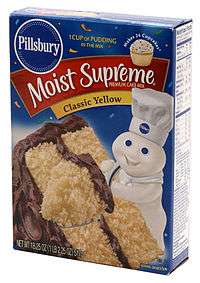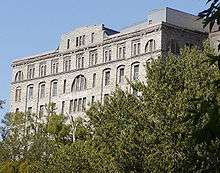Pillsbury Company
 The Pillsbury logo | |
 Pillsbury Cake Mix (a Smucker Co. product) | |
| Product type | Refrigerated and baking products |
|---|---|
| Owner |
General Mills (The Pillsbury Company) (brand owner; refrigerated products manufacturer) The J.M. Smucker Company (brand licensee; baking products manufacturer) |
| Country | U.S. |
| Introduced | 1872 |
| Tagline | Give it a Pop |
| Website |
pillsbury.com pillsburybaking.com |
| Public | |
| Industry | Food processing |
| Fate | Acquired by General Mills; assets divided |
| Successor | General Mills |
| Founded | Minneapolis, Minnesota, U.S., 1872 |
| Defunct | 2001 |
| Headquarters | Minneapolis, Minnesota, U.S. |
| Website |
www |
Pillsbury is a brand name used by Minneapolis-based General Mills and Orrville, Ohio-based J.M. Smucker Company. Historically, the Pillsbury Company, also based in Minneapolis, was a rival company to General Mills and was one of the world's largest producers of grain and other foodstuffs until it was bought out by General Mills in 2001. Antitrust law required General Mills to sell off some of the products. General Mills kept the rights to refrigerated and frozen Pillsbury products, while dry baking products and frosting are now sold by Smucker under license.
Leo Burnett created Pillsbury's Doughboy and Jolly Green Giant, which are two of the agency's top brand icons.[1]
History
.jpg)
Founding and early development
C.A. Pillsbury and Company was founded in 1872 by Charles Alfred Pillsbury and his uncle John S. Pillsbury. The company was second only to Washburn-Crosby to use steel rollers for processing grain in the United States. The finished product required transportation, so the Pillsburys assisted in funding railroad development in Minnesota.
In 1889, Pillsbury and its five mills on the banks of the Mississippi River were purchased by a British company. The company also tried to purchase and merge with the Washburn Crosby Company (a precursor of General Mills), but the principals at Washburn prevented the takeover.[2]
In 1923, the Pillsbury family reacquired Pillsbury-Washburn Flour Mills Company, Limited which subsequently was incorporated in 1935 as Pillsbury Flour Mills Company.[3]
The 1950s
In 1949, the company introduced a national baking competition, which would come to be known as the Pillsbury Bake-Off; it was nationally broadcast on CBS for many years.
Only seven products used the Pillsbury name in 1950, but the company began adding to its product line.[4] The early 1950s brought the acquisition of Ballard & Ballard Company and the beginning of packaged biscuit dough, which would become one of the company's most important and profitable product lines in later decades. The company began advertising heavily on television. In 1957, Pillsbury commissioned a television commercial jingle (from its advertising agency Leo Burnett) with the main lyrics "Nothin' says lovin/Like somethin' from the oven/And Pillsbury says it best"; the jingle became a well-known signature of the company and was used, with modifications, in some form for at least the next 20 years.
Later corporate acquisitions included restaurants such as Burger King, Steak and Ale, Bennigan's, Godfather's Pizza, Häagen-Dazs and Quik Wok, plus popular grocery store food brands such as Green Giant.
The 1960s
In the 1960s, Pillsbury added Sweet* 10 made with cyclamate, which became the most popular artificial sweetener. In 1964, Pillsbury introduced Funny Face Drink Mix with the names Goofy Grape, Rootin' Tootin' Raspberry, Freckle Face Strawberry, Loud Mouth Lime, Chinese Cherry (later Choo-Choo Cherry), and Injun Orange (later Jolly Olly Orange). Lefty Lemon followed in 1965, along with other flavors. The Funny Face characters, as well as the Funny Face brand were created in 1963 by Hal Silverman, a Creative Director at Campbell Mithun Advertising. When cyclamate was banned, Sweet* 10 and Funny Face had to be dropped, resulting in a $4.5 million loss. Both products were re-introduced after changes, and the drinks became available sweetened and unsweetened.[4]
Another drink mix introduced in the 1960s was Moo Juice, a flavored powder combined with milk in a shaker to produce a milkshake. Moo Juice was also created by Hal Silverman. Its TV commercial featured a talking animation of the product's cartoon cow head mascot. This was voiced by Frank Fontaine, who was familiar at that time as Crazy Guggenheim in The Jackie Gleason Show's "Joe the Bartender" skits. Moo Juice was short-lived, as its milkshakes tended to be thin compared to similar products such as Borden's Frosted and Birds Eye's Thick and Frosty.
Among the other crazy kid foods that Silverman created for Pillsbury was Nugget Town, chocolate flavored nuggets that came in eight different, collectable packages that when popped open and folded made into a whole western town. The TV commercial featured Buddy Hackett as the voice of the town's little bear sheriff. Also, there was Gorilla Milk—"...you'll go ape for Gorilla Milk, a glass in the morning and you'll swing all day"—a protein additive that turned milk into an instant breakfast. This product, aimed at teenagers, was not successful going against Carnation Instant Breakfast.
That decade, Pillsbury also created Space Food Sticks to capitalize on the popularity of the space program. Space Food Sticks were developed by Robert Muller, the inventor of the HACCP standards used by the food industry to ensure food safety.
When NASA astronaut Scott Carpenter launched into space on Mercury capsule Aurora 7 in 1962, he was carrying with him the first solid space food – small food cubes developed by Pillsbury's research and development department. Taking Pillsbury scientists more than a year to develop, space food cubes were followed by other space-friendly foods, such as cake that was not crumbly, relish that could be served in slices, and meat that needed no refrigeration.
It acquired Burger King in 1967.[5]
The 1980s and after
In 1989, the British company Grand Metropolitan (later Diageo) purchased the food maker, and during this ownership period the company divested itself of all production and distribution facilities (contracting these functions to other companies), making itself simply a marketing entity for its own brands (Pillsbury, Green Giant, Old El Paso, Totino's, etc.).
In 2001, Diageo sold Pillsbury to its old rival, General Mills. However, the baking products division was sold to International Multifoods Corporation, which was later acquired by Smucker's. Pillsbury sold all of their restaurant brands and exited the business completely by the late 1990s.
Notable achievements



Pillsbury once claimed to have the largest grain mill in the world at the Pillsbury A-Mill overlooking Saint Anthony Falls on the Mississippi River in Minneapolis. The building had two of the most powerful direct-drive waterwheels ever built, each putting out 1200 horsepower (900 kW).
See also
Footnotes
- ↑ "SEC Info – Publicis Groupe SA, Bcom3 Group". March 7, 2002. and "The Green Giant". Advertising Age. 2005 [1999]. Retrieved April 23, 2007.
- ↑ Gray, James (1954). Business without Boundary: The Story of General Mills. University of Minnesota Press. p. 50. LCCN 54-10286.
- ↑ "Pillsbury Company". Encyclopædia Britannica. 2007. Retrieved April 21, 2007.
- 1 2 "Funny Face History". Retrieved February 8, 2010.
- ↑ Smith, Andrew F. (August 30, 2006). Encyclopedia of junk food and fast food (1st ed.). Greenwood Publishing Group. pp. 27–28. ISBN 0-313-33527-3.
References
- N.S. Gill. Charles Alfred Pillsbury. Minneapolis.about.com
- Andrew Haeg (July 17, 2000). General Mills Acquires Pillsbury. Minnesota Public Radio.
